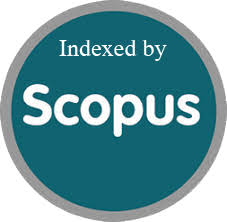Mathematical Modelling and PID Controller Implementation to Control Linear and Nonlinear Quarter Car Active Suspension
Abstract
In this work, linear and nonlinear designs of active suspension models are proposed to develop and improve quarter-car systems. To simplify stability assessment, a second-order system is proposed for both linear and nonlinear cases. The linear system consists of mass, spring, and damper components, while the nonlinear system includes the same components with additional nonlinear parts for stiffness and damper. Moreover, the state space of the linear and nonlinear is presented as a preparatory step before applying the analysis methods to validate the models. After that, the stability of linear and nonlinear systems is characterized using Matlab simulations to compare suspension performance parameters such as rise time (tr), settling time (ts), and peak overshoot (Mp). The simulation results of the linear system for each of tr, ts, Mp were0.097612sec, 2.3 sec, and 0.3839 cm, respectively, while the results of the nonlinear system were 0.52237 sec, 20.16 sec, and 0.3064 cm, respectively. In addition, the results for linear and nonlinear systems indicate the need to improve ride comfort and road handling using PID controller design. Consequently, it is possible to reach a better compromise than is possible using pure elements, without a controller). Finally, the active suspension system for both linear and nonlinear systems is improved through the application of a PID controller, resulting in the following values for the linear system: tr = 0.10721sec, ts = 1.693 sec, and Mp = 0.3682cm. Similarly, the nonlinear system showed improved performance with tr = 0.259775sec, ts = 1.325 sec, and Mp = 0.0734cm.
References
- , Elbab, Allam, E., Hady, M., and Abouel-Seoud, S., (2009) "Performance of Active Suspension with Fuzzy Control," SAE Technical Paper 2009-01-1614.
- A. Dahunsi and J.O.Pedro, "Neural network-based identification and approximate predictive control of a servo-hydraulic vehicle suspension system," Engineering Letters, vol. 18, no. 4, pp. 357-368, Nov. 2010.
- A. H. Oraby, M. A. Aly, S.M. El-Demerdash, A. M. Selim (2007) .Influence of Active Suspension Preview Control on the Vehicle Lateral Dynamics SAE 2007-01-2347.
- Al Aela, A.M., Kenne, J.-P. and Mintsa, H.A. (2020) Adaptive Neural Network and nonlinear electrohydraulic active suspension control system, Journal of Vibration and Control, 28(3-4), pp. 243259. Available at: https://doi.org/10.1177/1077546320975979.
- Al-Holou, T. Lahdhiri, D. Joo, J. Weaver, and F. Al-Abbas, (2002) Sliding mode neural network inference fuzzy logic control for active suspension systems, IEEE Trans. Fuzzy Syst., vol. 10, no. 2, Apr. 2002, pp. 234246.
- Basargan, H. et al. (2021) Fault-tolerant semi-active suspension control for degradation in damper performance, 2021 29th Mediterranean Conference on Control and Automation (MED) [Preprint]. Available at: https://doi.org/10.1109/med51440.2021.9480288.
- Cetin and A. V. Akkaya, "Simulation and hybrid fuzzy-Pill control for positioning of a hydraulic system," Journal of Dynamic Systems,Measurement and Control: Transactions of ASME, vol. 61, pp. 465-476, Nov. 2010.
- Du H, Zhang N. H control of active vehicle suspensions with actuator time delay. J Sound Vib 2007; 301(12):23652.
- Elnaz Akbari, Morteza Farsadi, Intan Z.Mat Darus ,Ramin Ghelichi (2010) Observer Design for Active Suspension System U sing Sliding Mode Control Proceedings of 2010 IEEE Student Conference on Research and Development, 13 - 14 Dec 2010, Putrajaya, Malaysia.
- Gad, A.S., Oraby, W. and Metered, H. (2020) Vibration control of semi-active vehicle suspension system incorporating mr damper using fuzzy self-tuning PID approach, SAE Technical Paper Series [Preprint]. Available at: https://doi.org/10.4271/2020-01-1082.
- Guo, H. Liu, Z. Luo, and F. Wang, ''Adaptive Pill controller based on BP neural network," in Proceedings of the 2009 International Conference on Artificial Intelligence (JCAI '09), Hainan Island, Apr.2009, pp. 148-150.
- Hanafi, "PID controller design for semi-active car suspension based on model from intelligent system identification," in Proceedings of the Second International Conference on Computer Engineering and Applications, Bali Island, Indonesia, Mar. 2010, pp. 60-63.
- J. Astrom and T. Hagglund, "The future of Pill control," Control Engineering Practice, vol. 9, pp. 1163-1175, Nov. 2001.
- Li, W. et al. (2019) Robust adaptive sliding mode PI control for active vehicle seat suspension systems, 2019 Chinese Control And Decision Conference (CCDC) [Preprint]. Available at: https://doi.org/10.1109/ccdc.2019.8832368.
- Lu, Y., Wang, H. and Tian, Y. (2018) Active disturbance rejection control for active suspension system of Nonlinear Full Car, 2018 IEEE 7th Data Driven Control and Learning Systems Conference (DDCLS) [Preprint]. Available at: https://doi.org/10.1109/ddcls.2018.8516039.
- Marzbanrad, G. Ahmadi, Y. Hojjat, H. Zohoor, (2002) Optimal active control of vehicle suspension systems including time delay and previewfor rough roads, Journal of Vibration and Control 8, 967991.
- Marzbanrad, Y. Hojjat, H. Zohoor, S.K. Nikravesh, (2003) Optimal previewcontrol design of an active suspension based on a full car model, Scientia Iranica 10, 2336.
- Nagarkar, M. et al. (2022) Design of passive suspension system to mimic fuzzy logic control active suspension system, Beni-Suef University Journal of Basic and Applied Sciences, 11(1). Available at: https://doi.org/10.1186/s43088-022-00291-3.
- O'Dwyer, Handbook of PI an PID Controller Tuning Rules. London: hnperial College Press, 2006.
- P. Phalke, A. C. Mitra. Comparison of passive and semi-active suspension system by MATLAB SIMULINK for different road profiles. IOSR Journal of Mechanical & Civil Engineering (IOSRJMCE), pp. 38-42, 2016.
- PC Chen, Huang AC. (2005) .Adaptive sliding control of non-autonomous active suspension systems with time-varying loadings. J Sound Vib; 282(35):111935.
- Pekgkgz, R.K. et al. (2010) Active suspension of cars using fuzzy logic controller optimized by genetic algorithm, International Journal of Engineering and Applied Sciences, 2(4), pp. 2737.
- Rosli, R., Mohamed, Z. and Priyandoko, G. (2021) Semi active seat suspension system using modified intelligent active force control, International Journal of Automotive and Mechanical Engineering, 18(1). Available at: https://doi.org/10.15282/ijame.18.1.2021.09.0644.
- S. Yahaya, and M. R. A. Ghani, (2000) LQR Controller for Active Car Suspension, Proc. On TENCON, Malaysia.
- Sam and K. Hudha, "Modelling and force tracking of hydraulic actuator for an active suspension system," in Proceedings of the IEEE conference on Industrial Electronics and Applications, (ICIEA 2006),Singapore, May 2006, pp. 1-6.
- Shahid, Y. and Wei, M. (2019) Comparative analysis of different model-based controllers using active vehicle suspension system, Algorithms, 13(1), p. 10. Available at: https://doi.org/10.3390/a13010010.
- Shao, S.-J., Jing, D. and Ren, C.-B. (2020) Multiobjective optimization of nonlinear active suspension system with time-delayed feedback, Mathematical Problems in Engineering, 2020, pp. 111. Available at: https://doi.org/10.1155/2020/9526359
- Shehata, A., Metered, H. and Oraby, W. (2019) Fuzzy self-tuning PID controller for semi-active vehicle suspension system incorporating mr damper, SAE Technical Paper Series [Preprint]. Available at: https://doi.org/10.4271/2019-01-0455.
- Shimoya, N. and Katsuyama, E. (2019) A study of Triple Skyhook Control for semi-active suspension system, SAE Technical Paper Series [Preprint]. Available at: https://doi.org/10.4271/2019-01-0168.
- Soliman, A.M.A. and Kaldas, M.M.S. (2019) Semi-active suspension systems from research to mass-market a review, Journal of Low Frequency Noise, Vibration and Active Control, 40(2), pp. 10051023. Available at: https://doi.org/10.1177/1461348419876392.
- Soudani, M.S. et al. (2019) Comparison between a passive and active suspension vehicle using PID and fuzzy controllers with two entries applied on Quarter Vehicle Model, 2019 1st International Conference on Sustainable Renewable Energy Systems and Applications (ICSRESA) [Preprint]. Available at: https://doi.org/10.1109/icsresa49121.2019.9182349.








